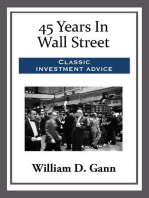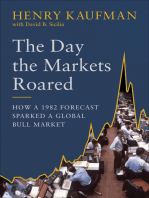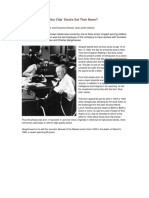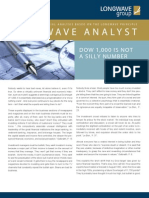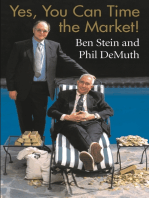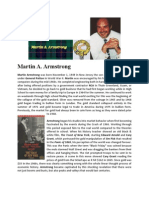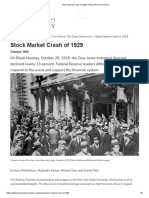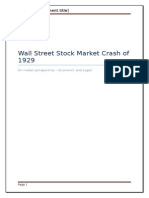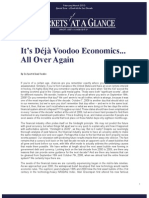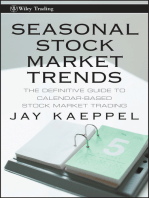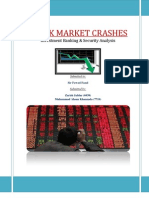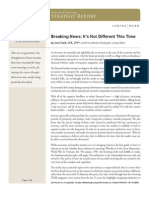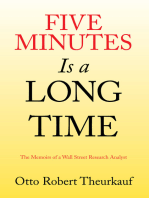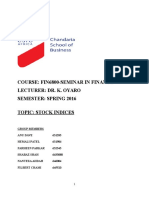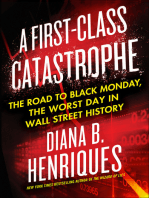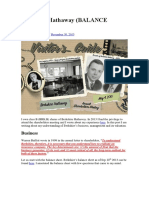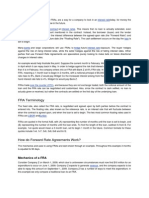Bolsa Gen
Bolsa Gen
Uploaded by
Michael Cano LombardoCopyright:
Available Formats
Bolsa Gen
Bolsa Gen
Uploaded by
Michael Cano LombardoOriginal Title
Copyright
Available Formats
Share this document
Did you find this document useful?
Is this content inappropriate?
Copyright:
Available Formats
Bolsa Gen
Bolsa Gen
Uploaded by
Michael Cano LombardoCopyright:
Available Formats
MTA - Market Technicians Association http://knowledgebase.mta.org/?fuseaction=kb.resource&kbDomai...
10. Indicator Analysis (Trend and Momentum)
11. Market Technicians Association Educational Foundation (MTAEF)
Gould, Edson Beers
Knowledge Base ID: 1.6.07
Currently
1/5
Stars.
Average Rating: 0.0
Submit Additional Information
Tags: Edson Gould, Gould
Visits: 923
Edson B. Gould
Provided by George A. Schade, Jr., CMT
Investment manager and Forbes columnist Kenneth Fisher wrote of Edson Gould:
“Market technician Edson Gould always laughed at the idea of having a significant
influence on the stock market, but his predictions were the most precise around. He
pinpointed major bull markets and prophesied bottom-out markets as if he had his own
peephole into the future. But in place of a crystal ball and wacky off-the-cuff schemes, his
were smart, intensely researched and time-tested theories that made him a legend in the
investment community.”
I. Biography
Edson Gould spent over 60 years working in and studying financial markets. Gould studied the arts at
Princeton, engineering at Lehigh (from where he graduated in 1922), and finance at New York
University. In 1922, after working for a short time at Western Electric, he joined Moody’s Investor
Service as an analyst and later was editor of Moody’s Stock Survey, Bond Survey, and Advisory Reports.
In 1948, he began at Arthur Wiesenberger & Company, where he developed and edited the well-known
Wiesenberger Investment Report and became a senior partner. He also was Research Director at E. B.
Smith (which later became Smith Barney), and worked for Nuveen.
In the early 1960’s, he founded his publication Findings & Forecasts. In December 1969, Anametrics,
Inc., an investment advisory firm, bought Findings & Forecasts. Gould edited Findings & Forecasts and
2 of 16 8/22/11 12:36 07PM
MTA - Market Technicians Association http://knowledgebase.mta.org/?fuseaction=kb.resource&kbDomai...
chaired the firm’s investment committee. It was during this time that Gould attained his greatest fame.
His 14-16 page reports had a high readership of some 2,500 subscribers.
Gould appeared three times on Wall Street Week. Louis Rukeyser welcomed him on November 12, 1976
(with guests Bob Nurock and Marty Zweig):
“If there’s a technical market analyst in Wall Street with a better track record than Edson
Gould, we haven’t found him yet in seven seasons of looking….his forecasts…have an
immediate market impact that no other technician can match.”
Technician Walter Deemer has related to me that Gould was the “hottest technician in the 1960’s.” Once
after Gould issued a bullish report on SCM, an office equipment company, Gerry Tsai (the “gunslinger”
manager made famous in Adam Smith’s The Money Game) bought 25,000 shares and then another
25,000 shares until SCM moved past $60.00, which had been Gould’s target price. According to
Deemer, Gerry Tsai knew that Edson Gould was an analyst to follow.
In late 1976, he began managing the Edson Gould Fund, possibly one of the first mutual funds to be
managed using technical analysis. In early 1977, the fund was holding “growth and glamour stocks”
such as Ford, Citicorp, McDonalds, and Gannett, the kind of stocks that had lost their luster up to then.
In fact, Gould maintained a “Glamour Stock Average,” an index of growth stocks.
Gould’s popular fame has centered on some of his uncannily accurate stock market forecasts. These
forecasts were presented in major reports which he issued for the year ahead. Some of his better known
forecasts were:
1. In 1962, Gould predicted that the DJIA would rise another 400 points but the great bull market
that had started in 1942 would end in 1966. The bull market expired on February 11, 1966 at
1001.11, having risen from 93 in 1942.
2. In October, 1972, with the DJIA at 940, he said the DJIA would rise to 1040 - 1050 by year’s end.
The DJIA rose to 1051.70 on January 11, 1973.
3. On January 16, 1973, in a “special sale bulletin” he urged subscribers to sell, believing the bull
move that had started in 1970 at 800 was over. By December 1974, the DJIA plummeted 497
points.
4. In November, 1979 in his report titled The Sign of the Bull, he wrote: “The ‘unexpected’…is an
intermediate-term DJIA move over the next several years to the 1200-1400 level, with an eventual
move up to the 2500-3000 level by the mid-to late-1980’s.” These levels were reached in 1989. In
The Sign of the Bull, he concluded: “[T]he…years ahead are quite likely to produce a new and
exciting period - one that should meet the expectations of even the most optimistic bulls.” We
know what the stock market did after 1982.
Yet Gould was not perfect with all his forecasts. In January 1975, in a Barron’s panel, he expressed the
opinion that gold would move up to $258 “during the first half of the year, maybe the first three months”
of 1975. Gold had just reached a high of $195.25 during the last week of December 1974. But it was in
May 1979, four years later, when gold moved above $258.
Gould’s interest in market forecasts can be traced to his early career. In early 1935, he told Barron’s
editors that 1937 would see a bear swing. The DJIA fell 32.82% in 1937. He wrote articles, published in
Barron’s in 1937 and 1941, under the name of Edson Beers. Barron’s wrote:
3 of 16 8/22/11 12:36 07PM
MTA - Market Technicians Association http://knowledgebase.mta.org/?fuseaction=kb.resource&kbDomai...
“In the spring of 1937.…Mr. Beers was practically the only one to write back that all
purchases should be postponed until later in the year. His forecast of a bear swing during
1937, incidentally, was first made to Barron’s in early 1935.”
II. What Factors Did Gould Consider?
The November1976 interview with Rukeyser is enlightening. Gould said:
“[T]here are three factors that determine…the level of the stock market and the trend
thereof. You can list them as economic, monetary and what I call psychological. Now, the
monetary factors are always early, but they’re very important. They give you the early
warning of a change. The economic factors are always late….And the so-called
psychological factors that I use, they’re concurrent.”
Monetary Factors
Gould developed the Three Steps and a Stumble Rule, which states that shortly after the Federal Reserve
raises either the discount rate or margin requirements or reserve requirements three consecutive times
without a decline, the stock market is likely to suffer a substantial, perhaps serious, setback. The Federal
Reserve sets these three monetary rates. The first signal occurred in November 1919. According to Ned
Davis, between 1919 and April 2000, following a signal, the DJIA has declined a median 17.0% over a
median period of 18 months. Gould had indicated that there would be a time lag after the signal.
After having had a very good record, after the 1989 signal, according to Davis, the rule’s track record
“has been mixed.” Davis now tracks the changes in the federal funds rate. The reason is that the Federal
Reserve began to rely less on the discount rate and to rely more by changing the fed funds rate,
tightening or loosening bank reserves, or by buying and selling dollars.
In Stocks for the Long Run, Professor Jeremy Siegel also wrote that after 1990, investors should not
count on the predictable effect of central bank policies as they had in the past. The effect of credit
tightening actions is now well discounted in the market. In the March 8, 2004, issue of Barron’s, there
was an article based on Ned Davis’ research showing DJIA changes for select periods following from
one to six interest rate increases.
The important point is that Gould believed - as he wrote in December 1965 - that “the stock market is
importantly a function of money and credit, and the monetary factors are among the earliest indicators of
major turning points in the stock market.” Today we understand the importance of the Federal Reserve’s
actions. Gould was one of the first technicians to try “to quantify and qualify the tightening credit
situation” because he had learned that “at some point tightening money and credit … can increasingly
become a cause of the next downturn” in the stock market.
Psychological Factors
Gould was influenced by French psychologist and sociologist Gustave le Bon’s 1895 book on mass
psychology The Crowd: A Study of the Popular Mind. The book “brought me the realization that the
action of the stock market is nothing more nor less than a manifestation of crowd psychology. With this
insight, an apparently irrational stock market became comprehensible.”
In 1937, Gould wrote, “Men are today dominated in their business actions by the primary emotions of
4 of 16 8/22/11 12:36 07PM
MTA - Market Technicians Association http://knowledgebase.mta.org/?fuseaction=kb.resource&kbDomai...
greed and fear just as they have been for many thousands of years (psychology)…” Gould believed that
stocks sell at the prices they do “because of what the mass of investors think they are worth.” He
believed that “the market is shaped by human emotions.”
The Senti-meter was Gould’s measurement of crowd psychology or the “definitive limits to sentiment”
(he coined the term Senti-meter). The Senti-meter is the Price/Dividend ratio, or the price of $1.00 worth
of dividends. It is a sentiment indicator. The premise of the Senti-meter is that while earnings might be
illusory, dividends “are what the stockholder receives, that which he can spend,” and therefore, of
greater influence to investors. Kenneth Fisher has called the Price/Dividend Ratio “the single most
powerful indicator of long term stock market direction I’ve seen. It’s so simple, but inexplicably
powerful.”
Gould calculated the Senti-meter by dividing the DJIA each month by the dividends paid by the Dow
stocks for the preceding twelve months. The Senti-meter looked like a thermometer. See Figure 1. Gould
called the chart depiction of the ratio the “Senti-graph.”
The Senti-meter demonstrated that there are “definable and measurable limits to the emotions of the
crowd of investors,” helped determine “the concurrent degree of long-term risk in the stock market,” and
afforded a “framework for making assumptions regarding the probable or potential extent of long-term
moves in the stock market.”
Gould interpreted a ratio above 30 to show a high level of enthusiasm (or what some would call an
overbought market) which evidences a high and risky market. A ratio below 15 indicates worry, lower
still fear, and below 10 panic (oversold markets), or price levels that historically have been great buying
opportunities or “relatively safe” or “near riskless markets.”
During the Depression, the Senti-meter fell to 10.02; the lowest ratio after 1900 had been 8.71 in late
1917. High readings in the 32 to 36 range occurred at market highs in the 1960’s and earlier during the
1930’s. The reading preceding the 1929 crash was 33.67.
According to stock market researcher Robert W. Colby, “The Sentimeter worked well as an indicator
until the years 1991-2000, when the big bull market blew out all historical norms by a wide margin.”
Since 1991, the Price/Dividend ratio has been over 32, and today is around 50. To some commentators,
this high ratio is more proof of a continuing stock market mania.
III. Decennial Pattern
Edgar Lawrence Smith, with the assistance of Anthony Gaubis, pioneered the Decennial Pattern, and
Smith’s decennial chart was first published in 1939. The Decennial Pattern shows the annual per cent
change for every year of a decade. The Decennial Pattern has been constructed for each full decade from
1881-1890 through 1991-2000.
Smith found that each decade showed three bull market cycles, each of approximately 40 months
duration. The strongest bull market cycle was in the middle of the decade. The pattern shows that the 5th
year is the strongest year of a decade; the 8th year is a very bullish year; the 1st and 10th years are the
most bearish years; and the 2d, 3rd, 4th, and 6th years are good years. See Table 1 and Chart 1. In the
annual Stock Trader’s Almanac, Yale Hirsch updates his “Decennial Cycle” table.
5 of 16 8/22/11 12:36 07PM
MTA - Market Technicians Association http://knowledgebase.mta.org/?fuseaction=kb.resource&kbDomai...
In 1971, Edgar Lawrence Smith wrote that Gould had used Smith’s chart of the Decennial Pattern,
published in 1939, “as a basis for a correct appraisal of the probable course of stock prices in 1955.”
Gould wrote in a report titled Omens for 1955, issued in late 1954:
“Our own view is and has been that September 1953 witnessed the beginning of a major
bull market that should carry the DJIA well above 400 and last through 1955 and probably
beyond…”
Between September 14, 1953, and April 6, 1956, the DJIA rose 103.9%. The DJIA was up 20.77% in
1955. Gould’s forecast for 1955 was based on the Decennial Pattern’s very strong bull market in the fthfi
year of a decade. Smith concluded, “This, then, shows that an elementary study of periodic recurrences
made in the early thirties and published in 1939 was still of use in 1954 to provide a sound appraisal for
1955.”
Gould updated Smith’s decennial chart through 1970 and published it in his 1974 stock market forecast.
Gould’s and Smith’s charts were constructed using monthly average stock prices for each decade from
1881-1890 through 1961-1970.
The Decennial Pattern was a cornerstone of Gould’s technical analysis, and it influenced others. In The
Right Stock at the Right Time, Larry Williams wrote that after studying Gould’s analysis of “the 10-year
pattern for stock prices,” he had “been handed, figuratively speaking, the keys to the kingdom of stock
market forecasting.”
IV. Speed Resistance Lines
Gould developed Speed Resistance Lines (“SRL”). These lines show how fast a trend is moving up
(down) based on a significant low (high) and a recent high (low). Visually, they are similar to Fibonacci
fan lines, and sometimes are called One-Third and Two-Thirds Lines.
SRLs can be rising or falling. For a rising SRL, the vertical distance between a recent high and a noted
low is divided into thirds. Straight lines are drawn from the noted low through the one-third and
two-thirds points of the vertical distance. A falling SRL is drawn by dividing the vertical distance from a
noted high to a recent low into thirds and drawing straight lines from the high through the one-third and
two-thirds points on the vertical distance.
Often, the one-third and two-thirds lines act as support or resistance. An up trend that corrects down to
the rising two-thirds line, for example, would indicate that the one-third line may be the next support
level.
His well-known indicators may have lost some usefulness, but they were the result of careful study
grounded in historical observations, and their usefulness may be confirmed again. We can learn much
from Edson Gould’s passion for the markets and intense manner of research.
In 1983, Gould retired to his 35-acre farm in Pennsylvania, where he died in March 1987, at age 85
years.
Figure 1. SCHEMATIC OF EDSON GOULD’S SENTI-METER
Limits of Emotions of Yield Price of $1
6 of 16 8/22/11 12:36 07PM
MTA - Market Technicians Association http://knowledgebase.mta.org/?fuseaction=kb.resource&kbDomai...
the Crowd of Investors Basis of Dividends
Enthusiasm 3% $33
!! High and Risky Market !! $30
Confidence 4% $25
Hope 5% $20
Caution 6% $17
"" Low and Near Riskless Market "" $15
Worry 7% $14
Fear 8% $12
Panic 10% $10
Based on Dow Jones Industrial Average prices and dividends.
Annual Percent Change in Standard & Poor's Composite Index
1881-1890 through 1981-1990 Decades
Year of Decade 1st 2nd 3rd 4th 5th 6th 7th 8th 9th 10th
Total Percent Change 25% 32% 27% 64% 254% 47% -74% 164% 41% -36%
Up Years 7 8 4 6 10 7 3 8 8 3
Down Years 3 2 6 4 0 3 7 2 2 7
Notes: (1) Based on average December prices. (2) No data recorded for 1881-1884 and 1986-1990.
Source: Williams, Larry, The Right Stock at the Right Time, p. 11 (2003)
Annual Percent Change in the Dow Jones Industrial Average
1881-1890 through 1991-2000 Decades and 2001
1st 2nd 3rd 4th 5th 6th 7th 8th 9th 10th
0.1% 39.9% 40.8% 88.7% 368.6% 71.5% -38.3% 221.7% 110.6% -86.9%
7 of 16 8/22/11 12:36 07PM
MTA - Market Technicians Association http://knowledgebase.mta.org/?fuseaction=kb.resource&kbDomai...
Source: This article is based upon research done by George A. Schade, Jr., CMT. He can be reached at
aljschade@aol.com.
Comments
No comments have been made yet.
© Copyright 2011 Market Technicians Association. Privacy Policy | Contact | Site Map Global Cloud®
8 of 16 8/22/11 12:36 07PM
You might also like
- Larry Williams Stock Trading and Investing Course Part 1Document64 pagesLarry Williams Stock Trading and Investing Course Part 1Hanuman Sai Majeti100% (11)
- LWStock Trading Investing CourseDocument241 pagesLWStock Trading Investing CourseWorld New75% (4)
- Mbo TemplateDocument1 pageMbo Templatesriwhyni0% (1)
- Strategic Audit On Mercedes BenzDocument21 pagesStrategic Audit On Mercedes Benztinah100% (3)
- Futures 201107 enDocument11 pagesFutures 201107 ensuxessNo ratings yet
- Scientific Stock Speculation by CH DowDocument110 pagesScientific Stock Speculation by CH DowAbdullah18100% (2)
- Geico Case Study PDFDocument22 pagesGeico Case Study PDFMichael Cano LombardoNo ratings yet
- Business Department: BTEC Tech Award in EnterpriseDocument25 pagesBusiness Department: BTEC Tech Award in EnterpriseNatalia SkowronNo ratings yet
- The Blow-Up Artist: Can Victor Niederhoffer Survive Another Market Crisis?Document20 pagesThe Blow-Up Artist: Can Victor Niederhoffer Survive Another Market Crisis?TerezkaMNo ratings yet
- PW Anatomy of The BearDocument8 pagesPW Anatomy of The BeargodlionwolfNo ratings yet
- The Snowball Effect Using Dividend Interest Reinvestment To HelpDocument349 pagesThe Snowball Effect Using Dividend Interest Reinvestment To HelpEfeogheneNo ratings yet
- 33 - The Forerunners To Behavioral FinanceDocument3 pages33 - The Forerunners To Behavioral FinanceHoa Tống KiềuNo ratings yet
- 2020.Q3 Goehring & Rozencwajg Market CommentaryDocument33 pages2020.Q3 Goehring & Rozencwajg Market Commentarygenid.ssNo ratings yet
- The Day the Markets Roared: How a 1982 Forecast Sparked a Global Bull MarketFrom EverandThe Day the Markets Roared: How a 1982 Forecast Sparked a Global Bull MarketRating: 5 out of 5 stars5/5 (1)
- Ever Wonder How Blue Chip' Stocks Got Their Name?Document1 pageEver Wonder How Blue Chip' Stocks Got Their Name?colleenf-1No ratings yet
- Dow 1000 Is Not A Silly NumberDocument18 pagesDow 1000 Is Not A Silly NumberNathan Martin100% (1)
- May 2007 SandspringDocument7 pagesMay 2007 SandspringpaseqNo ratings yet
- Delong Shleif Er 91Document27 pagesDelong Shleif Er 91mgmagnitudeNo ratings yet
- The Broyhill Letter: Executive SummaryDocument3 pagesThe Broyhill Letter: Executive SummaryBroyhill Asset ManagementNo ratings yet
- Friday December 30, 2005 Section C Copyright 2005 / TheDocument2 pagesFriday December 30, 2005 Section C Copyright 2005 / ThewmccabeNo ratings yet
- 1 Martin Armstrong Biography May 2011Document63 pages1 Martin Armstrong Biography May 2011Sidewinder747No ratings yet
- Stock Market Crash of 1929 - Federal Reserve HistoryDocument6 pagesStock Market Crash of 1929 - Federal Reserve HistoryThomas WilliamsNo ratings yet
- Top 11 Richest Forex Traders and Their Net Worth (For 2024)Document1 pageTop 11 Richest Forex Traders and Their Net Worth (For 2024)babatundewilliams54No ratings yet
- Wall Street Stock Market Crash of 1929Document24 pagesWall Street Stock Market Crash of 1929Rananjay TalwarNo ratings yet
- Basic Points 2007Document455 pagesBasic Points 2007bschwartzieNo ratings yet
- The Case for Long-Term Value Investing: A guide to the data and strategies that drive stock market successFrom EverandThe Case for Long-Term Value Investing: A guide to the data and strategies that drive stock market successNo ratings yet
- MAAG - Its Deja Vododoo Economics All Over Again - March 2010Document6 pagesMAAG - Its Deja Vododoo Economics All Over Again - March 2010rhyzimmer02No ratings yet
- Merchant Banking & Investment Lecture 01Document198 pagesMerchant Banking & Investment Lecture 01Mehedi HasanNo ratings yet
- Stocks Breaking Down: Wednesday's Action Still Makes Me NervousDocument10 pagesStocks Breaking Down: Wednesday's Action Still Makes Me NervousAlbert L. PeiaNo ratings yet
- Á Trends For Long Time Frames, Trends For Medium Time FramesDocument56 pagesÁ Trends For Long Time Frames, Trends For Medium Time FramesOzina LopesNo ratings yet
- STJIC Adviser Letter 2024 Q3 (1)Document8 pagesSTJIC Adviser Letter 2024 Q3 (1)Robert ZhangNo ratings yet
- Costa, Neil A. - How Would W. D. Gann See The Stock Market in 2001Document5 pagesCosta, Neil A. - How Would W. D. Gann See The Stock Market in 2001Graham GloverNo ratings yet
- 7 Deadly Investment SinsDocument11 pages7 Deadly Investment Sinsqualityresearch100% (1)
- How To Buy Stocks Louis C EngelDocument278 pagesHow To Buy Stocks Louis C EngelAnthony H Yang100% (1)
- Redleaf Andy Absolute Return WhiteboxDocument6 pagesRedleaf Andy Absolute Return WhiteboxMatt Taylor100% (1)
- Taylor & Francis, Ltd. Financial Analysts JournalDocument5 pagesTaylor & Francis, Ltd. Financial Analysts JournalSneha BalaaNo ratings yet
- The Stock Market Crash of 1929Document13 pagesThe Stock Market Crash of 1929Katsuzo NishiNo ratings yet
- The Biggest Trades of All TimeDocument4 pagesThe Biggest Trades of All TimeChrisTheodorouNo ratings yet
- The Coming Currency Collapse and what you can do about itFrom EverandThe Coming Currency Collapse and what you can do about itRating: 5 out of 5 stars5/5 (1)
- Contrarian InvestorDocument2 pagesContrarian InvestorGaurav JainNo ratings yet
- Summary of Jack D. Schwager & Charles Faulkner's The New Market WizardsFrom EverandSummary of Jack D. Schwager & Charles Faulkner's The New Market WizardsNo ratings yet
- HMMM Jul 08 2012Document27 pagesHMMM Jul 08 2012teidukasNo ratings yet
- Seasonal Stock Market Trends: The Definitive Guide to Calendar-Based Stock Market TradingFrom EverandSeasonal Stock Market Trends: The Definitive Guide to Calendar-Based Stock Market TradingNo ratings yet
- Married To The Market: High/LowDocument2 pagesMarried To The Market: High/LowOoi Ban JuanNo ratings yet
- The February 1973 Devaluation of The Dollar and Gold Value ClauseDocument12 pagesThe February 1973 Devaluation of The Dollar and Gold Value ClauseJuan Pablo Jaramillo RestrepoNo ratings yet
- Stock Market Crashes: Investment Banking & Security AnalysisDocument19 pagesStock Market Crashes: Investment Banking & Security AnalysisDanish SHakeelNo ratings yet
- Historical View of The Financial Market We Are inDocument8 pagesHistorical View of The Financial Market We Are indredamNo ratings yet
- Research Paper On Stock Market Crash of 1929Document7 pagesResearch Paper On Stock Market Crash of 1929woeatlrif100% (1)
- BULL V Bear. Dr.D.R.raj Sir FinalDocument15 pagesBULL V Bear. Dr.D.R.raj Sir FinalrnaganirmitaNo ratings yet
- Stock Market Crash ThesisDocument6 pagesStock Market Crash Thesisrokafjvcf100% (1)
- Brief History of Mutual FundsDocument3 pagesBrief History of Mutual FundsrandommdudeNo ratings yet
- About Jeffrey NicholsDocument2 pagesAbout Jeffrey NicholsNoah Grabowitz100% (2)
- Investing Without PeopleDocument18 pagesInvesting Without PeopleZerohedgeNo ratings yet
- Stock Market Index Final 12 March 2016Document69 pagesStock Market Index Final 12 March 2016Anu DaveNo ratings yet
- A First-Class Catastrophe: The Road to Black Monday, the Worst Day in Wall Street HistoryFrom EverandA First-Class Catastrophe: The Road to Black Monday, the Worst Day in Wall Street HistoryRating: 4 out of 5 stars4/5 (33)
- Market Commentary 12-10-12Document3 pagesMarket Commentary 12-10-12CLORIS4No ratings yet
- 0727_BkDocument199 pages0727_BkrichardlandekNo ratings yet
- Bolsa-Gen 4Document12 pagesBolsa-Gen 4Michael Cano LombardoNo ratings yet
- Cross-Border Trading As A Mechanism For Implicit Capital Flight: Adrs, Cedears and The Argentine CrisisDocument44 pagesCross-Border Trading As A Mechanism For Implicit Capital Flight: Adrs, Cedears and The Argentine CrisisMichael Cano LombardoNo ratings yet
- Bolsa-Gen 1Document46 pagesBolsa-Gen 1Michael Cano LombardoNo ratings yet
- Letter To Shareholders: 667 Madison Ave. New York, NY 10065Document20 pagesLetter To Shareholders: 667 Madison Ave. New York, NY 10065Michael Cano LombardoNo ratings yet
- Interview With Dr. J. Mark Mobius of Franklin Templeton InvestmentsDocument6 pagesInterview With Dr. J. Mark Mobius of Franklin Templeton InvestmentsMichael Cano LombardoNo ratings yet
- Adr 3Document23 pagesAdr 3Michael Cano LombardoNo ratings yet
- Adr 2Document37 pagesAdr 2Michael Cano LombardoNo ratings yet
- Miami Movie-The Specialist (1994)Document21 pagesMiami Movie-The Specialist (1994)Michael Cano LombardoNo ratings yet
- DangerZone XPO 2016 05 16Document7 pagesDangerZone XPO 2016 05 16Michael Cano LombardoNo ratings yet
- Berkshire Hathaway Balance Sheet Analysis (EXCELLENT)Document38 pagesBerkshire Hathaway Balance Sheet Analysis (EXCELLENT)Michael Cano LombardoNo ratings yet
- Danaher Corporation: 2017 OverviewDocument30 pagesDanaher Corporation: 2017 OverviewMichael Cano Lombardo100% (2)
- 16 Reglas Sir John MX EsDocument4 pages16 Reglas Sir John MX EsMichael Cano LombardoNo ratings yet
- Fortune - GE Under SiegeDocument6 pagesFortune - GE Under SiegeMichael Cano LombardoNo ratings yet
- Hull OFOD11 e Solutions CH 28Document7 pagesHull OFOD11 e Solutions CH 28Park GeunhyeNo ratings yet
- Game TheoryDocument16 pagesGame TheoryVivek Kumar Gupta100% (1)
- AFAR02-10 - ForexDocument2 pagesAFAR02-10 - ForexNicoleNo ratings yet
- Quiz On MEDocument52 pagesQuiz On MEDrHemant ShastryNo ratings yet
- Cover PageDocument14 pagesCover PageMadukaNo ratings yet
- Avalara Sales Tax GuideDocument10 pagesAvalara Sales Tax GuideJonathan ArcherNo ratings yet
- BCG Matrix: The Growth Share Matrix Was Created in 1968 by BCG's Founder, Bruce HendersonDocument4 pagesBCG Matrix: The Growth Share Matrix Was Created in 1968 by BCG's Founder, Bruce HendersonRuhul Amin Rasel100% (1)
- PP Invt&sec 2018Document5 pagesPP Invt&sec 2018Revatee HurilNo ratings yet
- Economic Insight Food PricesDocument8 pagesEconomic Insight Food PricesVivek AgarwalNo ratings yet
- Regulatory Functions & Processes: Cristina Lu E RanilloDocument13 pagesRegulatory Functions & Processes: Cristina Lu E RanilloCristina Lu Elmundo RanilloNo ratings yet
- Chapter 1 Business ActivityDocument4 pagesChapter 1 Business ActivityAishath Nabahath IbrahimNo ratings yet
- Mie L1 AbDocument38 pagesMie L1 AbSakshi MNo ratings yet
- Theinvestorsbook Com Managerial Economics HTMLDocument14 pagesTheinvestorsbook Com Managerial Economics HTMLMohamed Mohideen SarhoonNo ratings yet
- Forward Rate AgreementsDocument3 pagesForward Rate AgreementssahilgeraNo ratings yet
- Risk Aversion - Mean VarianceDocument35 pagesRisk Aversion - Mean VarianceVaidyanathan RavichandranNo ratings yet
- Chapter1. The Investment Banking Paradigm DefinitionDocument26 pagesChapter1. The Investment Banking Paradigm DefinitionSharayu BavkarNo ratings yet
- A Study On Consumer Perception With Reference To Girias Investment PVT LTD, BengaluruDocument71 pagesA Study On Consumer Perception With Reference To Girias Investment PVT LTD, BengaluruPRASANT KUMAR SAMALNo ratings yet
- Alex PortfolioDocument5 pagesAlex PortfolioSindhuja KumarNo ratings yet
- Defining The Focal Market: Professor Ethan Mollick @emollickDocument10 pagesDefining The Focal Market: Professor Ethan Mollick @emollickRidhya MahajanNo ratings yet
- Fm-May-June 2015Document18 pagesFm-May-June 2015banglauserNo ratings yet
- Management Accounting CVP AnalysisDocument29 pagesManagement Accounting CVP AnalysisJanani RamanandNo ratings yet
- CRNM Trade Brief Volume 19Document5 pagesCRNM Trade Brief Volume 19Office of Trade Negotiations (OTN), CARICOM SecretariatNo ratings yet
- Sebi Investor Awareness Programme - : Secondary MarketDocument15 pagesSebi Investor Awareness Programme - : Secondary MarketRahul ShakyaNo ratings yet
- WFS Course PlanDocument49 pagesWFS Course PlanBhuva_janaNo ratings yet
- Brokerage Calculator: Sample Contract NoteDocument1 pageBrokerage Calculator: Sample Contract NotebasanisujithkumarNo ratings yet
- Honda Entering AustraliaDocument2 pagesHonda Entering AustraliaTyStimpertNo ratings yet
- Summer Internship PresentationDocument18 pagesSummer Internship PresentationDivyam GoelNo ratings yet


